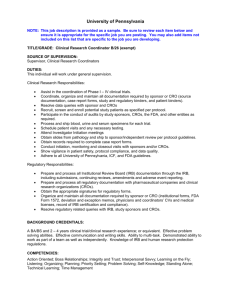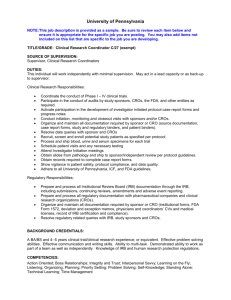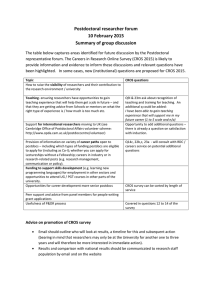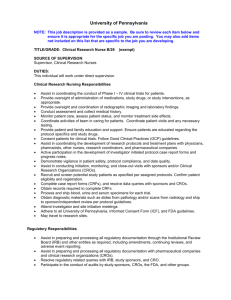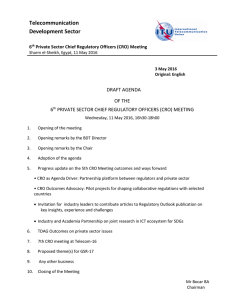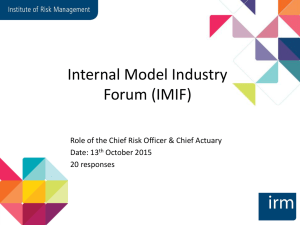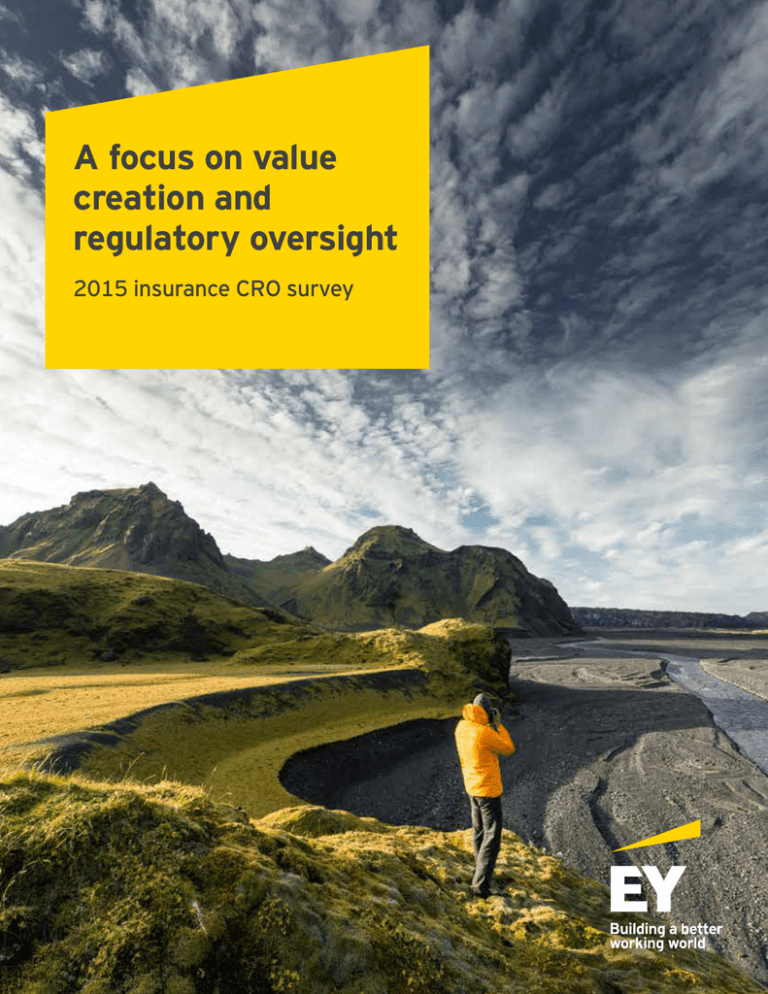
A focus on value
creation and
regulatory oversight
2015 insurance CRO survey
Contents
Executive summary
1
Section 1
Three key themes
4
Section 2
Overview 6
Section 3
Organizations and operations
10
Section 4
Measures and models
16
Section 5
Regulation20
Section 6
Looking ahead
24
Executive summary
EY’s fifth annual survey of chief risk officers (CROs) in the insurance
industry continues to show the strategic evolution of the role, as well
as the increasing sophistication and maturation of risk management
capabilities. It is clear from this year’s results that CROs are dealing
directly with many of the most important changes buffeting the
industry. Thus, it is possible to see the most profound forces of
change in insurance reflected in the evolution of the CRO role.
In other words, the profile and value of CROs continue to rise as
effective risk management is increasingly viewed as a requirement
for market success.
Further, the results from this year’s survey confirm that risk
management has been increasingly “operationalized” as an essential
part of managing an insurance business. The rising authority,
expanding responsibilities and higher organizational profiles of CROs
that were highlighted in previous surveys are being manifested
tangibly across the organization in multiple ways, including:
•Direct participation on key strategic business matters
•Larger staffs
•Wider use of stress testing
A focus on value creation and regulatory oversight 2015 insurance CRO survey |
1
Executive summary
Risk frameworks are no longer conceptual in
nature, but have been broadly implemented
in the form of multiple lines of defense. Risk
appetites have been clearly defined and are
being actively used to manage the business.
As one survey respondent put it, risk
management is closely “integrated with the
business, rather than being an afterthought.”
One significant change for CROs — especially
those at midsized carriers — is the likely
convergence of state-based regulations
with federal guidelines. Many CROs are
facing up to the reality that there won’t be
one distinct risk management framework
for those insurers designated in the US as
systematically important financial institutions
(SIFIs) and another for non-SIFIs. This
represents a significant shift in thinking
from just a few years ago. The expectation
is that state regulators will become more
prescriptive and may be pushed to adopt
similar standards and guidelines to those
established by federal regulators, and that
they will use Own Risk Solvency Assessments
(ORSA) to better manage this transition. The
implication is that the CRO agenda will only
get longer.
While past results highlighted the evolution
of CRO responsibilities, this year’s survey
was designed for greater specificity and
granularity in terms of defining the CRO
role in providing input on decision-making
in critical risk areas and understanding
how CROs interact with other parts of the
business. For instance, many companies
have spent the last few years building their
analytical and economic capital capabilities;
the results illustrate how insurers are using
such capabilities.
Feedback from participants in past surveys
led to the addition of these new questions.
Overall, the survey is structured around
high-level topics (overview), organizations
and operations, measures and models,
regulations and the future (looking ahead).
The goal is to gain a sense of today’s CRO
daily realities and the story behind the
statistics. Both the story and the statistics
are shared on the following pages.
2
| A focus on value creation and regulatory oversight 2015 insurance CRO survey
The impact of industry
events and trends on
survey results
It is important to interpret the CRO survey
results in light of industry trends and broader
economic events that occurred during the
period of the survey, which was conducted
from December 2014 through February
2015. The economy continued to improve
and most of the rating agencies issued stable
ratings for both the property and casualty
(P&C) and life insurance industries. The
specific events highlighted below may have
affected survey responses:
• Serious concern and much uncertainty
resulted from the failure of a divided
U.S. Congress to extend the Terrorism
Risk Insurance Act (TRIA) by year-end
2014. The legislation eventually passed in
January 2015.
• The December 2014 release of the IAIS
(International Association of Insurance
Supervisors) Consultation Document
spelled out plans to develop and finalize
an international capital standard (ICS) for
Internationally Active Insurance Groups
(IAIGs) and Globally Systemically Important
Insurers (G-SIIs). The IAIS will conduct field
tests throughout 2015.
• The Federal Reserve Board (FRB) was in
the process of conducting a quantitative
impact study (QIS) on the impact of bank
capital standards on insurance companies
under FRB supervision. With the
modification of the Collins Amendment,
the FRB has more flexibility to consider
alternate capital adequacy standards for
insurers subject to FRB regulation and
supervision.
• The Federal Insurance Office continued to
make its presence felt through the release
of a study of the impact of reinsurance on
the US insurance industry.
About EY’s CRO Survey
From December 2014
through February 2015,
EY insurance risk analysts
conducted interviews with
chief risk officers and other
senior risk executives from
20 North American insurance
companies. As with previous
annual insurance CRO
surveys, the goal was to
document and detail
“top of mind” issues for the
insurance industry’s risk
management leaders. Survey
respondents represent life,
P&C and multi-line insurers,
and a range of sizes, including
focused midsized carriers
and some of the largest and
most diversified companies.
A number are under Federal
Reserve Board supervision
or have parent companies
subject to Solvency II (SII).
A focus on value creation and regulatory oversight 2015 insurance CRO survey |
3
Section 1
Three key themes
Capital standards continue to confuse
The lack of common accounting standards and capital measures makes it difficult to compare performance and
solvency across companies. Insurers employ a variety of different capital measures, many of them specific to the
company, to analyze their risk exposures over a range of time periods and under different normal and adverse
scenarios. The recent QIS by the Federal Reserve Board and the field testing by the IAIS have motivated a number
of companies to propose new approaches to regulatory capital treatment. Much work remains to be done in this
area. One CRO observed that “all regulation is ultimately local” and that, based upon the current SII requirements,
his company could lower its capital requirements by buying Greek bonds.
Grudging acceptance of more regulations and more intrusive
regulatory oversight
One of the big changes from prior surveys is that CROs from insurers not explicitly regulated by the Federal
Reserve Board now expect that they will soon face similarly tough oversight. They also recognize that federal
requirements for insurers will continue to evolve. In the past, these CROs were confident that current statebased requirements would remain unchanged. Now, they realize that the two regulatory regimes, with different
risk management standards, are likely to converge around the more stringent guidelines. As one CRO remarked
of the changing regulatory outlook, “You need to prepare to be treated like a SIFI.”
Risk management is a team sport
CROs have spent the last few years dealing with a series of crisis situations and establishing risk frameworks
for their companies. The 2015 survey shows CROs spending more of their time and effort on integrating risk
management practices into the business — a clear indicator of the maturation of risk management functions across
the industry. In fact, for some CROs, the value of the risk management function is chiefly measured in terms of
its integration with the business. That more business units themselves are expanding their risk management
capabilities and hiring more risk staff shows how risk management has become truly a team sport played across
and at every level of the enterprise.
4
| A focus on value creation and regulatory oversight 2015 insurance CRO survey
A focus on value creation and regulatory oversight 2015 insurance CRO survey |
5
Section 2
Overview
6
| A focus on value creation and regulatory oversight 2015 insurance CRO survey
Overview
Q1. What was your most important
Other
accomplishment over the past year?
15%
In the 2014 survey, many CROs cited establishing risk appetite and an economic
capital framework as their key accomplishments. Although these areas remain
important to CROs, this year’s key accomplishments involve building out the risk
framework with a particular focus on governance. A few companies have just
started building their risk frameworks, while others, with more mature frameworks,
are on their second or third iterations.
Risk
quantification
ORSA
12%
29%
Integration with
the business
The big surprise is the number of CROs reporting that their biggest accomplishment
was integrating risk frameworks and practices into the business, as well as legal
and compliance functions. This development reflects increasing recognition that
the risk management function cannot be an island; if it is to function properly
and effectively, risk management must be owned, endorsed and implemented by
first-line risk owners.
What CROs say:
“Overall, the organization structure is in a
better place, with more formal breakouts of
operational risk and risk quantification.”
“We established new positions, with senior
risk management officers that are part of
risk, but also embedded in business units
around the world.”
The other significant shift from last year is the decreasing focus on ORSA work;
this is no surprise as initial reports are due in 2015. Last, risk quantification
work is still important but not to the same extent as last year.
“Our biggest strides were better integrating
with compliance and legal.”
Q2. Compared to a year ago, has the size
“Our most important accomplishment was
making sure things are done consistently,
from office to office and from risk to risk.”
of your department increased, stayed the
same or decreased?
CROs also recognize that the competition for talent is intensifying. Consulting
firms, regulatory authorities and insurance companies are all competing for the
same limited pool of resources. There is even competition for talent within the
companies, as individual businesses are competing with the risk management
organization for individuals with risk and compliance skills. Some companies are
retraining risk staff so they can perform new risk tasks and activities that are
in high demand.
ERM
framework/
governance
12%
Governance enhancements include strengthening the three lines of defense and
expanding relationships with the board; as directors increase their focus on risk
management, some CROs are involved in discussions about the possibility of
establishing a board-level risk committee.
Over 70% of this year’s respondents reported an increase in staffing in their risk
function during the previous 12 months. Stress testing, operational risk, ORSA and
model risk management were the most commonly cited areas of staffing expansions.
32%
Stayed the same
22%
Decreased
6%
72%
Increased
A focus on value creation and regulatory oversight 2015 insurance CRO survey |
7
Overview
Q3. What are the biggest risk challenges
Other
facing the insurance industry today?1
13%
Cyber
Terrorism risk
insurance act
14%
40%
Regulation/
capital
standards
10%
10%
Competition/
pricing
13%
Interest rates/
economy
What CROs say:
“Good risk management can never be
imposed by the regulators.”
“The biggest risk is the complete change
in the regulatory landscape, much of which
is inconsistent.”
“More group supervision and capital
standards will have an impact on everybody.”
“The regulatory environment is the number
one, two and three biggest risks.”
“Let’s give Solvency II a chance to succeed
or fail.”
“We could be losing focus on the real
business risks — underwriting, geopolitical,
pricing and market.”
CROs are concerned about the pace and direction of regulations — a finding
consistent with previous CRO surveys. However, unlike past years, CROs now believe
that they may affect the pace — but not the direction — of coming regulations.
Not surprisingly, pending common capital standards are of overwhelming concern
to insurance CROs. Respondents come from many companies that are not regulated
by the FRB and unlikely to be in the foreseeable future, yet these CROs realize that
multiple sets of minimum capital standards are unworkable and that there likely will
be convergence toward the standards ultimately adopted by the FRB. Thus, they
expect such a regulatory shift to present formidable challenges in the near future
(see question 15).
The answers reflect the growing acceptance that potential IAIS and the Federal
Reserve Board standards will eventually impact all insurers, not just those firms
designated as SIFIs or those that are Savings and Loan Holding Companies (SLHCs).
Not being designated as a SIFI is no longer viewed as a “safe haven.”
Some respondents feel that focusing on regulatory matters leads CROs to take
“their eyes off the prize.” In other words, the focus should be on value creation
through effective management of traditional insurance industry risk — equity, credit,
underwriting and insurance.
In other areas, low interest rates and overall economic conditions are less of a
concern to CROs; this year, only 13% of respondents cited these as the biggest
risk, compared to 23% in last year’s survey. There is concern that competition is
increasing and margins are narrowing (especially within P&C).
That 10% of respondents cited TRIA as the biggest risk likely reflects the concern at
the time of the survey that the legislation might not pass. Now that it has passed,
TRIA is less of a hot topic for CROs. Cybersecurity remains a major risk issue for
CROs, with recent high-profile breaches in insurance and other sectors undoubtedly
feeding their concerns. The CRO focus on cyber risks is an excellent example of the
expanding role beyond traditional financial risk categories.
1 Because this question had multiple answers, the percentages of responses were calculated
and rounded for a total of 100%.
8
| A focus on value creation and regulatory oversight 2015 insurance CRO survey
Overview
Q4. How do you know that the risk function
is creating value?
Other
14%
Stakeholder
approval
Approximately a third of CROs reported that their biggest accomplishment for
2014 was integrating the risk function into the business (see question 1). It is
clear that they believe that such integration drives management dialogue around
the risk agenda and that risk management works best when there is active
discussion (and perhaps disagreement) among the business units.
Management understanding of risk and risk processes is another way that CROs
believe they can deliver value to the business. Survey responses make clear that
management cannot adequately participate in the dialogue unless it understands
the risk concepts and how CROs work to manage and mitigate risk exposures.
Value is created when “business people learn the vocabulary of risk,” according
to one respondent.
CROs also equate value with influence: if their opinions and perspectives carry
weight with the executive team, then the function is creating value. For instance,
in a strategic planning context, CROs like to provide their forward-looking
perspective, and their analytical tools can further contribute to the analysis and
discussion.
Interestingly, only 6% of CROs responded that value is best measured through
external approvals from the regulators, rating agencies or the parent company.
Impact on
strategy
6%
37%
9%
Management
dialogue/
discussion
11%
Integration
23%
Management understanding/
risk management influence
What CROs say:
“Risk is part of the decision making and
has influence on decisions that are made.”
“The measure of value is whether there
is anything that surprised management.
If they get surprised, then that is a failure
of the risk department.”
“The value is still hard to quantify — you can
determine if a process doesn’t have good
controls, but putting on new controls doesn’t
actually mean you saved something. Hedging
you can quantify — controls you can’t.”
“If everyone understands what risks the
organization is exposed to, then we are
doing our job.”
“Executive management understands the
major risk that can bring the company down.”
A focus on value creation and regulatory oversight 2015 insurance CRO survey |
9
Section 3
Organizations and
operations
10
| A focus on value creation and regulatory oversight 2015 insurance CRO survey
Organizations
and operations
Q5. What type of corporate governance
model is in place in your organization?
16%
The majority of respondents reported that their risk function is organized along
a hybrid model, where certain risk responsibilities and authorities are delegated
to the business units. Despite the prevalence of the hybrid model, there is active
discussion about whether risk management works best in a centralized model.
Evolving regulations and advances in the three-lines approach are creating
momentum for a centralized model. This includes having the second line
responsible for establishing the corporate risk framework and the supporting
policies and procedures. At the same time, more focus is being placed on the
first line to explicitly own the risks. More evolution is to be expected as CROs
seek the right models for their organizations.
Regardless of structure, CRO reporting relationships continue to move toward
direct accountability to the CEO and the board of directors. However, about
50% of respondents still report to the CFO, with dotted lines to the board.
Almost all respondents reported having full access to the board, regardless
of reporting line, both on a formal and informal basis. They are also reporting
to different committees of the board, which can include audit, risk, technology
and compensation.
Federated
(decision-making
authority largely rests
at business unit
or legal entity level)
21%
63%
Hybrid
(decision-making
authority is largely
delegated, with
specific areas of
control retained
at group or holding
company level)
Centralized
(decision-making
authority largely
rests at group
or holding
company level)
What CROs say:
“We have a hybrid model, but it still requires
a strong centralized body. We get consistency
with common policies and procedures.”
“Our hybrid approach is very dependent
on the people in the business units and
their ability to properly execute their risk
responsibilities.”
“As a result of the crises and Solvency II,
we are moving toward centralized structure
with three lines of defense.”
“If you look at the root causes of
destructive events, they occurred under
a decentralized structure where the
CRO was not empowered.”
A focus on value creation and regulatory oversight 2015 insurance CRO survey |
11
Q6. What are the responsibilities and authority of
the risk function?
A number of CROs identified having influence in key corporate decisions as an important
element of value creation. To develop a more complete picture of the roles and responsibilities
of the CRO, survey participants were asked to describe their authority and influence in a
number of risk and risk-related areas. As the table on the next page shows, the responses
fall along a continuum — from full ownership of certain decisions to playing only an advisory
role to having no input into decisions.
The results demonstrate the diverse responsibilities and many different ways CROs interact
with the rest of the organization. It also illustrates varying maturation levels for the CRO role
at different organizations. CROs in companies that have recently begun to improve their risk
management practices reported their authority and influence was limited. For instance, in
companies where the risk function is less evolved, the CRO generally provides far less risk
input regarding investments, strategic decisions, model governance, model validation and
other areas.
The table presents strong evidence that CROs in organizations with more advanced or mature
risk management programs exercise complete authority in such areas as:
• Risk appetite definition
• Tolerance limit setting
• Scenario and stress testing design
• Model governance and validation
12
| A focus on value creation and regulatory oversight 2015 insurance CRO survey
Organizations
and operations
Because these activities are integral parts of
establishing and monitoring the risk appetite,
the CRO’s dominant role is not surprising. This
finding is important because risk appetite and
limit setting play an increasingly significant role
in linking day-to-day activities to risk appetite by
placing boundaries on setting of and execution
of a company’s strategic plan. Further, CROs are
placed at the center of this critical process. It is
also interesting to note that CROs are moving
beyond traditional financial risk management.
For example, their involvement is increasing in
new product development and other areas. It is
clear that CROs’ unique perspective and ability
“to look around corners” have become highly
sought-after skills.
All respondents emphasized that even in
the areas where they have a veto, decisions
are often made in committee settings. In the
committee decision-making process, CROs are
expected to challenge assumptions and share
their points of view from a risk perspective. In
these situations, the CRO’s role as “effective
challenger” is critical. Some CROs mentioned
that the responsibility to escalate concerns to
the CEO or board is always in the background.
Riskappetite
appetitesetting
setting
Risk
25%
Risk tolerance and limits setting
Risk tolerance and limit setting
Business strategy
20%
20%
45%
20%
50%
65%
Business
strategy
Capital
deployment
StressCapital
and scenario
design 5%
deployment
Product approval
Stress and scenario design
Investments
Product approval
Strategic decisions (e.g., M&A)
5% 5%
5% 5%
15%
10% 10%
70%
75%
15%
55%
10%
Investments
Risk
mitigation
20%
5%
20%
5%
20%
50%
10% 5%
10%
25%
Model(e.g.,
governance
Strategic decisions
M&A) 5% 5%
55%
5% 10%
20%
Model validation
Risk mitigation 5% 5%
55%
5% 10%
20%
Model governance
40%
5%
30%
5%
20%
Model validation
40%
5%
30%
5%
20%
60
80
0
20
40
100
Reason
Reason
Risk owns a decision
Risk owns a decision
Risk has a veto
Risk has a veto
Risk is part of the decision committee
Risk is part of the decision committee
Risk has a voice but no veto
Risk has a voice but no veto
Risk is an advisor
Risk is an advisor
NA
NA
A focus on value creation and regulatory oversight 2015 insurance CRO survey |
13
Organizations
and operations
Q7. Have you adopted a formal three lines
Limited
of defense model?
21%
No
5%
74%
Yes
The vast majority of insurers have adopted the three-lines-of-defense model
for risk management. First-line management owns the risk, the second line
(risk management) establishes the risk management framework and provides
independent challenge and monitoring, and the third line (internal audit) provides
assurance that the risk framework and the resulting policies and procedures are
operating as intended.
As with other aspects of risk management, the establishment of this model is
evolving as companies continue to refine their risk management frameworks and
processes. According to respondents, the biggest challenge is explicitly setting the
responsibilities of the three lines and addressing the many potential areas where
the lines may overlap.
For some CROs, the major concern regarding the three-lines-of-defense model
is that risks can be too far removed from the businesses. To work effectively,
the strengthening of the second line must not come at the expenses of weakening
the first line’s ownership of the risk. “Three lines is better in form than substance,”
said one CRO. “If the risk function is the only one to carry the ball, then we have
a problem.”
What CROs say:
“Compliance is not part of risk but we have a
strong partnership; their risk assessments are
consistent with our RCSA process.”
“There is great dialogue going on. We are
becoming more and more transparent.”
“We struggle with the risk and compliance
issues and who owns what. We are starting to
interact differently with them and to clarify
the grey lines.”
“We may bump heads occasionally. There is
the potential that compliance will report to
risk going forward.”
“The CRO and CCO are working through the
issues, but not sure what they should be. It
can be described as tense cooperation.”
14
Q8. Describe the relative responsibilities
and interactions with the compliance function
and your group in terms of the three lines
of defense.
As the compliance organization assumes more risk-related responsibilities (risk
framework and independent monitoring processes for anti-money laundering
and know-your-customer guidelines, consumer protection) as a second line of
defense function, there is a need for stronger cooperation and coordination
between compliance and risk teams. Increasing regulations, and thus compliance
requirements, reinforce the need for greater coordination.
However, at many firms, such coordination occurs largely on an informal and ad hoc
basis, usually when the CRO and Chief Compliance Officer (CCO) sit on the same
committees. Communication and alignment are aided in those companies that have
a common risk taxonomy, and risk assessment processes and tools.
In some companies, compliance handles primarily legal issues and interacts with
risk on legal and certain regulatory issues. At others, the continued existence of
a “gray line” between risk and compliance sometimes leads to disagreements.
A number of CROs reported no formal relationships, but cited their informal
interactions in the hallways with the compliance staff as a good communication
mechanism.
| A focus on value creation and regulatory oversight 2015 insurance CRO survey
Organizations
and operations
Q9. Describe the relative responsibilities
and interactions with internal audit and your
group in terms of the three lines of defense.
The relationship between risk and internal audit is generally more mature than
the relationship between risk and compliance. But it too is undergoing significant
changes. The risk responsibilities of internal audit are changing to reflect the
expansion of risk activities and responsibilities in both the first and second lines.
IA is facing increased audit responsibilities in the execution of the Enterprise Risk
Management program, including the Risk Control Self-Assessment process, the
resulting action plans and the model validation process. The tasks are facilitated
through cooperation and coordination with the second line.
What CROs say
“We are largely independent. We share
IA reports and takeaways as part of the
risk assessment process.”
“Internal audit is very independent. We
need more connectedness; they only use
some of the information coming out of
the second line.”
“Historically the third line did more of
the second line work within the organization
but that is shifting with the development
of risk management.”
The challenge with building this relationship is that the independence of internal
audit must be protected. However, some CROs would like more “connectedness”
with internal audit, in part because it helps develop a common perspective on risk
exposures and agreement on the relative risks of management responsibilities
between the second and third lines. The main avenue for cooperation tends to be
the working committees where both the risk function and internal audit participate.
A focus on value creation and regulatory oversight 2015 insurance CRO survey |
15
Section 4
Measures and
models
16
| A focus on value creation and regulatory oversight 2015 insurance CRO survey
Measures and
models
Q10. For which of the following risks have
you set quantitative limits?
35
25
30
78%
78%
63%
53%
20
Responses to this question clearly demonstrate the growing sophistication of views
of risk appetites across the insurance industry. They are no longer expressed simply
as qualitative statements.
Almost 80% of participants reported they have quantitative tolerances and limits
for credit and equity risks; slightly less than 70% have limits for insurance and
underwriting.
It is noteworthy that half of respondents reported that their companies have
quantitative limits for operations risks. Measuring operational risk presents special
challenges because of the diversity of risk types and the fact that loss events
tend to cluster around the median of the loss curve. In addition, operational risk
programs at many insurance companies are relatively new when compared to the
banking industry. Insurance companies have only started in this area.
Q11. What is your primary measure of
capital? How do you define economic capital?
The multiplicity of responses to this question reflects the diversity in the different
objectives for internal capital adequacy assessment. Each measure allows the
company to examine its current and future capital position through a different lens.
Not surprisingly, most companies use statutory capital as their primary measure,
though they also use GAAP and economic capital measures, depending on the
circumstances.
Looking at economic capital specifically, many companies use a one-year, marketconsistent measure, though they also make adjustments to the economic capital
results. More companies report using a hybrid measure to examine stress events,
according to respondents.
68%
15
10
5
0
Credit
Equity
Interest
rate
Insurance/ Operational
underwriting
What CROs say:
“We currently calculate EC, but have not
deployed it much yet. We will ultimately
integrate an economic view (not necessarily
EC, per se) into pricing, performance
measurement (RAROC), and capital
allocation.”
“I would define it as ‘other.’ It is a modified
economic approach that takes into account
the longer life of the liabilities — a one year
change with some smoothing elements.”
“In addition to different measures of capital,
we use a volatility measure — to avoid death
by a thousand cuts.”
A focus on value creation and regulatory oversight 2015 insurance CRO survey |
17
Measures and
models
What CROs say
“It is a formal process which combines stress
testing and scenario analysis. We use it to
examine product and Investment options.”
“We use it to examine events with big dollars.
As a management team we ask what can we
do with the scenario? What is the impact and
direction? What can we do to control?”
“We run three stress scenarios; hyperinflation, depression and falling rate/falling
equity (forwards, depression, and in the
middle). We recalculate EC at future point.”
21%
The use of stress testing and scenario analysis falls along a continuum. Some
companies are “just getting started” or use it primarily to test investments, while
other CROs report that they use it for “everything.” Despite these differences, all
CROs recognize stress testing as a powerful risk management tool.
Respondents who said their organizations use stress testing only on a limited basis
made clear that they were committed to expanding their stress testing capabilities
in the future. Esprit d’escalier seems to be at work here; that is, some CROs clearly
wish they had embraced stress testing sooner.
Many companies use stress testing under multiple scenarios to test or determine
capital strength and/or to define when mitigation strategies should come into
play. Respondents reported a wide range of probabilities in using stress tests, but
a significant percentage cited using them in “one in 200 years” events. Scenario
analysis is increasingly applied to examine the impacts of long-tail operational loss
events, like natural disasters and cyber terrorism.
program in place?
53%
26%
scenario analysis?
Q13. Do you have a formal model risk
Limited
No
Q12. How do you use stress testing and
Yes
Despite substantial progress over the past three years, insurance companies appear
to lag banks in the model governance and validation processes. Part of the reason
is that even as banks build out their programs, the methodology and approach
to model risk management continue to be strengthened. There have been recent
advances in regulatory expectations in a number of areas, including:
• Required documentation
• Model prioritization
• Performance testing
• Internal controls around the validation process
• Model risk reporting
A few companies continue to believe that model owners should have responsibility
for model risk management and should be the ones to validate and test models.
However, these companies are becoming a vanishing minority as first-line and
independent second-line responsibilities become clarified in this space.
As demonstrated in the responses to question 6, CROs at companies with a welldeveloped second line are increasingly taking ownership of the critical function.
Most companies use a prioritization scale of three to five categories. In companies
with well-established programs, high-priority models, which require a higher level
of objectivity, are validated through the use of outside parties or by the second or
third line of defense. Similarly, CROs from such companies report having 1 to 10
staff members dedicated to model risk management within the risk function. One
respondent expected model risk management staffing to grow from 10 to 50
during the next few years.
18
| A focus on value creation and regulatory oversight 2015 insurance CRO survey
A focus on value creation and regulatory oversight 2015 insurance CRO survey |
19
Section 5
Regulation
20
| A focus on value creation and regulatory oversight 2015 insurance CRO survey
Regulation
Q14. What specific regulations, actual
Solvency II
TRIA
or pending, will present the biggest
implementation challenge?2
Principle-based
reserving
Accounting
The prospect of federal regulations presents the greatest concern. More than
half of participants cited potential Federal Reserve Board regulations applicable
to insurers, particularly in the areas of capital management, as their primary
regulatory concern.
ORSA
4% 8%
7%
4%
23%
54%
FRB/
capital/FIO
On the other hand, the concern stems from the growing realization that the new
rules could eventually apply to all insurers, regardless of their designation as a SIFI.
Most of the CROs who participated in the survey expect state and other federal
regulators to level the playing field. According to one respondent, “You cannot have
best practices for a SIFI and then another set for everyone else.”
The perceived inevitability of federal regulations is a theme that emerges from
the responses to several questions. For instance, ORSA was listed as a concern
because companies need to submit their report in 2015 and it is the first time that
state regulators will have a comprehensive look at an insurance company’s risk
management practices. The effectiveness of these practices in normal and stressed
events will be of particular interest to state regulators. Some CROs raised questions
on how the examination process would change now that the examiners have such
sensitive information. Other CROs listed ORSA as a challenge because they expect
the regulations to become more stringent over time.
2 Because this question had multiple answers, the percentages of responses were calculated
and rounded for a total of 100%.
What CROs say
“ORSA, GSII, IAIS. The first two are not
big implementations, but pieces are
moving around an awful lot.”
“Risk management is very specific to
the company. However, regulators want
commonality and consistency. It creates
healthy tension.”
“If you are an NYIC examiner and one
company is a SIFI and another large
complex company is not, the review
will be the same.”
“No problem with ORSA — keep it simple
and practical.”
A focus on value creation and regulatory oversight 2015 insurance CRO survey |
21
Regulation
Q15. Does ORSA have value to the company
Some
beyond fulfilling a regulatory requirement?
5%
No
ORSA is the one regulation about which CROs are optimistic, with a clear majority
indicating that ORSA offers value to the business. However, it is worth noting that
respondents believe its value is ultimately limited.
21%
74%
Yes
Many have completed a draft and held discussions with their regulators. Despite the
relative ease of completing the report, some CROs expressed a concern in how the
report would eventually be used by regulators.
While the majority of CROs claim ORSA has value, most believe its value is limited.
Respondents believe ORSA offers value in several ways:
• Identifying possible gaps in risk management practices
What CROs say
• Promoting comprehensive communications with the business
“ORSA is very well aligned with what ERM
would be doing anyway and is an effective
way to communicate what risk management
is doing.”
For instance, one CRO reported that the exercise helped identify a gap in
operational risk processes. Another saw value in assembling the document,
particularly in writing the narrative that needs to show consistency and uniformity
between the three modules.
“It is helpful to align risk management
activities from across the organization and
increase the dialogue with the Board.”
But another respondent questioned its value as a communications tool. Specifically,
with more than 100 pages of text and appendices, the report can be unwieldy and
daunting to a business stakeholder.
“ORSA is not very useful; hopefully, it will
eliminate other reports.”
As for the ORSA report itself, risk management members have taken the lead
in writing the report, but they stress it is a team effort with contributions pulled
from many areas of the company. Most CROs reported that it would consist of a
discussion of around 40 to 60 pages and an appendix of 50 to 100 pages. A small
minority reported that their document would include more than 100 pages of
discussion and 100 to 500 pages of appendices. About half of the companies will
show the board a summary of the ORSA report and the other half will give it a full
report. In all cases, the full report is available to the board.
“It is becoming the ERM document which
we refer to for decision making and for
communicating with the business.”
“The biggest value of ORSA goes to
regulators. The value to us hopefully comes
through better examinations.”
22
• Aligning stress-testing assumptions through the business units
| A focus on value creation and regulatory oversight 2015 insurance CRO survey
A focus on value creation and regulatory oversight 2015 insurance CRO survey |
23
Section 6
Looking ahead
24
| A focus on value creation and regulatory oversight 2015 insurance CRO survey
Looking ahead
Q16. To which areas do you expect to devote
significantly more attention during the next
12 months, compared to the past 12?3
Last year’s responses were evenly split among a variety of tasks. This year, there
is more uniformity in responses; the Federal Reserve Board is expected to develop
a capital standard for the insurance companies it oversees. With the common
regulatory capital definition, those institutions would likely need to conduct stress
tests for normal and adverse scenarios and use the results of that analysis to
prepare their annual capital plans.
As a result, many CROs expect to devote significant time and resources to capital
management, stress testing and risk appetite definitions.
Results show the emergence of stress testing as an important risk management
tool, with fewer resources being devoted to economic capital. Integration
and transparency with the business is an ongoing effort that will carry over
into next year.
ORSA is conspicuously missing from the list of high-priority tasks. This is not
altogether surprising, given that many institutions participated in one of the
three pilots or have already produced an ORSA draft.
As with past years, companies expect to build or rebuild parts of their ERM
frameworks. A number of respondents reported continuing work on the risk
appetite, including aligning the corporate and business unit risk appetites.
Given that baseline capabilities have been implemented, CROs are increasingly
turning their attention to emerging risks.
Other
Operational
risks
Risk
appetite
9%
9%
28%
Capital
modeling/
stress testing
15%
9%
Emerging risks
15%
15%
ERM
framework/
governance
Integration/
transparency
What CROs say
“We have to understand how the firm is going
to behave in certain states or conditions.”
“There is sensitivity to specific capital shocks
to allow for better decision making.”
“Risk management is part science and part
art and part defense and part offense. The
overall objective is to optimize allocation of
capital.”
“Going forward external stakeholders have to
matter more.”
3 Because this question had multiple answers, the percentages of responses were calculated
and rounded for a total of 100%.
A focus on value creation and regulatory oversight 2015 insurance CRO survey |
25
Looking ahead
What CROs say
“We continue to grow as a partner with other
areas of the organization and will have more
influence within the organization.”
“Our responsibilities are increasing. There
will not be an area where the CRO would not
be expected to have a point of view. The CRO
will bring all pillars of risk together.”
“Internally, the CRO’s role will be elevated in
the stature and importance of the function
and activities. The size of the organization
and reporting responsibilities will increase.
We will have more strategic involvement.”
“The CRO will move to a more well-defined
role and clear responsibilities and authorities.
Companies won’t get their money’s worth if
they don’t give CROs that authority.”
Q17. Looking three to five years out, what
do you think will be the biggest differences in
the CRO role at that time compared to now?
Though the organizations surveyed are at different points in the evolution of
the CRO role, there is broad consensus about the end point of the process. The
majority of respondents believe that greater authority and accountability, increased
influence and broader interaction are inevitable. Similarly, respondents expect that
as the CRO role is better defined, it will become more visible and more accountable.
In the meantime, as the evolution continues, CROs are focused on performance
and creating value for the business. As one respondent put it, “we are spending
less time on defining and debating the role and approach and more time on
executing our risk plan.” Similarly, CROs are more involved with strategy and capital
management issues. Here again, risk management is rapidly becoming an integral
part of operations and an essential element of managing the business.
“There is more integration with the business
rather than risk management being an
afterthought.”
26
| A focus on value creation and regulatory oversight 2015 insurance CRO survey
A focus on value creation and regulatory oversight 2015 insurance CRO survey |
27
Conclusion
The evolution of the CRO role looks very likely to continue along its
current trajectory of increasing authority, influence and involvement
in more business decisions. Those CROs capable of demonstrating
value through such engagement will be best positioned to help
their companies manage proliferating market risks and ongoing
uncertainty around shifting regulations. Those regulations will
present significant challenges and have profound impacts on
the industry as a whole and on the role of the CRO at insurance
organizations. Given this alignment with “macro” industry trends
and drivers, it is no wonder that this year’s survey results revealed
widespread operationalization of the CRO agenda at many insurers.
28
| A focus on value creation and regulatory oversight 2015 insurance CRO survey
Thank you
EY wishes to express
its appreciation to the
CROs who took the time
to participate in this
year’s survey.
For more information about the survey
and findings, please contact:
Bill Spinard
Executive Director, Financial Services
Ernst & Young LLP
+1 301 648 4170
bill.spinard@ey.com
A focus on value creation and regulatory oversight 2015 insurance CRO survey |
29
EY | Assurance | Tax | Transactions | Advisory
About EY
EY is a global leader in assurance, tax, transaction and advisory services.
The insights and quality services we deliver help build trust and confidence
in the capital markets and in economies the world over. We develop
outstanding leaders who team to deliver on our promises to all of our
stakeholders. In so doing, we play a critical role in building a better working
world for our people, for our clients and for our communities.
EY refers to the global organization, and may refer to one or more, of the
member firms of Ernst & Young Global Limited, each of which is a separate
legal entity. Ernst & Young Global Limited, a UK company limited by
guarantee, does not provide services to clients. For more information about
our organization, please visit ey.com.
Ernst & Young LLP is a client-serving member firm of Ernst & Young Global
Limited operating in the US.
EY is a leader in serving the global financial services marketplace
Nearly 43,000 EY financial services professionals around the world provide
integrated assurance, tax, transaction and advisory services to our asset
management, banking, capital markets and insurance clients. In the
Americas, EY is the only public accounting organization with a separate
business unit dedicated to the financial services marketplace. Created in
2000, the Americas Financial Services Office today includes more than
6,900 professionals at member firms in over 50 locations throughout the
US, the Caribbean and Latin America.
EY professionals in our financial services practices worldwide align with key
global industry groups, including EY’s Global Wealth & Asset Management
Center, Global Banking & Capital Markets Center, Global Insurance Center
and Global Private Equity Center, which act as hubs for sharing industryfocused knowledge on current and emerging trends and regulations in
order to help our clients address key issues. Our practitioners span many
disciplines and provide a well-rounded understanding of business issues and
challenges, as well as integrated services to our clients.
With a global presence and industry-focused advice, EY’s financial services
professionals provide high-quality assurance, tax, transaction and advisory
services, including operations, process improvement, risk and technology, to
financial services companies worldwide.
© 2015 Ernst & Young LLP.
All Rights Reserved.
SCORE No. CK0930
1503-1424345 NY
ED None
This material has been prepared for general informational purposes only and is not intended to be
relied upon as accounting, tax, or other professional advice. Please refer to your advisors for specific
advice.
ey.com

